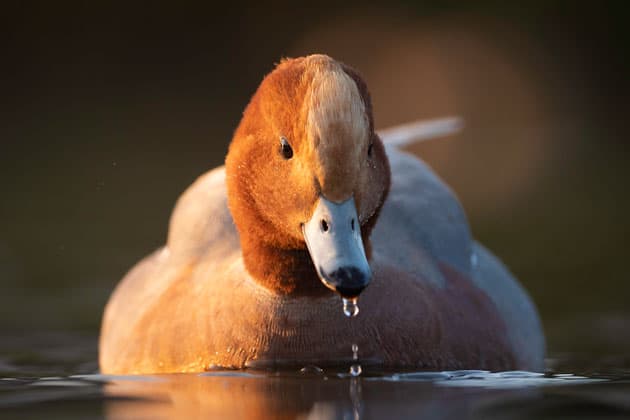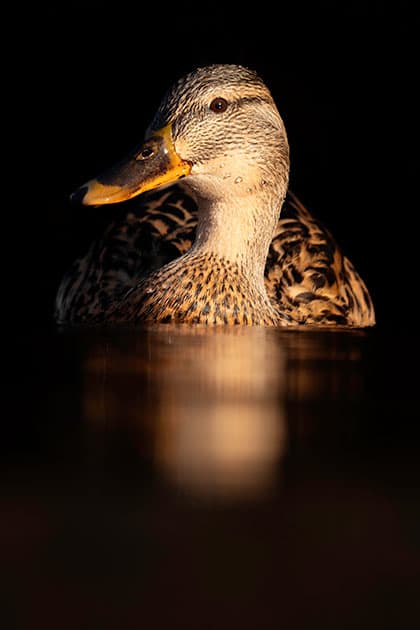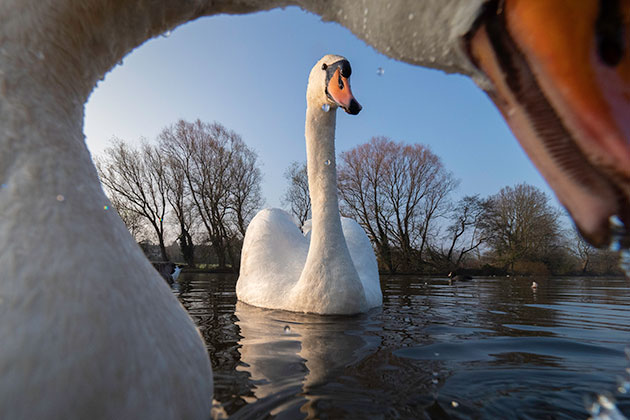About waterfowl
Waterfowl can be found extensively across the UK, but your local lake, pond or country park is usually a good place to start.
- Locations Lakes, ponds, rivers, wetlands and coastal stretches
- Bird size Ranging from 55cm to 2.4m wingspan. Up to 12kg
- Nest Usually near water, in dense vegetation, hollows in trees and small islands or refuges
- Diet Wide – ranging from fish to vegetation
- UK population Healthy. One million plus

Eurasian widgeon in the late evening light. Olympus E-M1 Mark II, 300mm, 1/800sec at f/4, ISO 800. Credit: Tesni Ward
One of the great things about photographing waterfowl is that they are so easily accessible in the UK. Despite this, they are often overlooked in pursuit of more elusive wildlife, and deemed to be ‘boring’ or ‘too easy’.
This can be hard to understand when you consider that the UK is home to over 35 species of waterfowl or wildfowl that can be found on many lakes, rivers and coastal areas. There is potential for truly great images if time and effort is put towards photographing them.
While there are big differences between some species, the most common include mallards, mute swans, coots and Canada geese. They are often more concentrated in urban areas and owing to regular contact with humans, are usually approachable when it comes to photography.
One of the downsides to working with these birds in an urban environment are the surroundings, which can be messy and clustered with cars, people, buildings and rubbish from time to time. A quick readjustment or moving to a new angle usually solves this.
Another challenge when working in an urban setting is that the sheer number of birds can make it difficult to get a clean image. I have lost count of the number of images I’ve had to give up on because of a bird photo-bombing in the front/rear of the image. Unfortunately this is hard to avoid, but perseverance and patience do pay off.
While some birds will be going into eclipse plumage at varying times in the summer, there are always subjects to photograph and it can be a good time to turn your attention to the females. Certain waterfowl such as mallards are known to have more than one brood each year, meaning you can get those adorable duckling images throughout the summer.

A dark background helped to isolate this hen mallard from her surroundings. Olympus E-M1X, 210mm, 1/1000sec at f/5, ISO 400. Credit: Tesni Ward
Shooting advice
When it comes to photographing waterfowl, one of the best things you can do is spend as much time as possible at your local site. You are more likely to dedicate time and energy into a site that’s nearby and which will be easier to swing by if you only have a bit of time on your hands.
Once there, try and shoot at the level of the birds. That either means getting into the water, using an articulated screen, or using a right-angle viewfinder. Of course there will be opportunities to shoot from different angles and perspectives, but images often draw your attention in better if shot from water level.
I shoot in manual mode but aperture priority is also a good option if you want to control your depth of field and minimise distractions. As I shoot with a 2x crop sensor, I prefer to shoot with my aperture wide open 90% of the time, but if shooting fast movement it’s advisable to have a wider depth of field so that you don’t miss the action.
When it comes to focusing, ensure that you focus on the eye of the bird whenever possible. Owing to the shape of these birds, focusing on the body sometimes results in the head or eye being out of focus. There’s also the risk of focusing on the bill. Use a single AF point or a wider depth of field to compensate for this.
Kit list
- Waders If it’s safe to do so, and getting in the water in waders will not cause undue stress or disturbance to wildlife, waders are a great way to get eye level with your subject for a unique angle on the action.
- Seeds If you’re struggling to get close enough, a small handful of cracked corn or wildfowl feed can help to break the deadlock! Try to avoid bread whenever possible.







